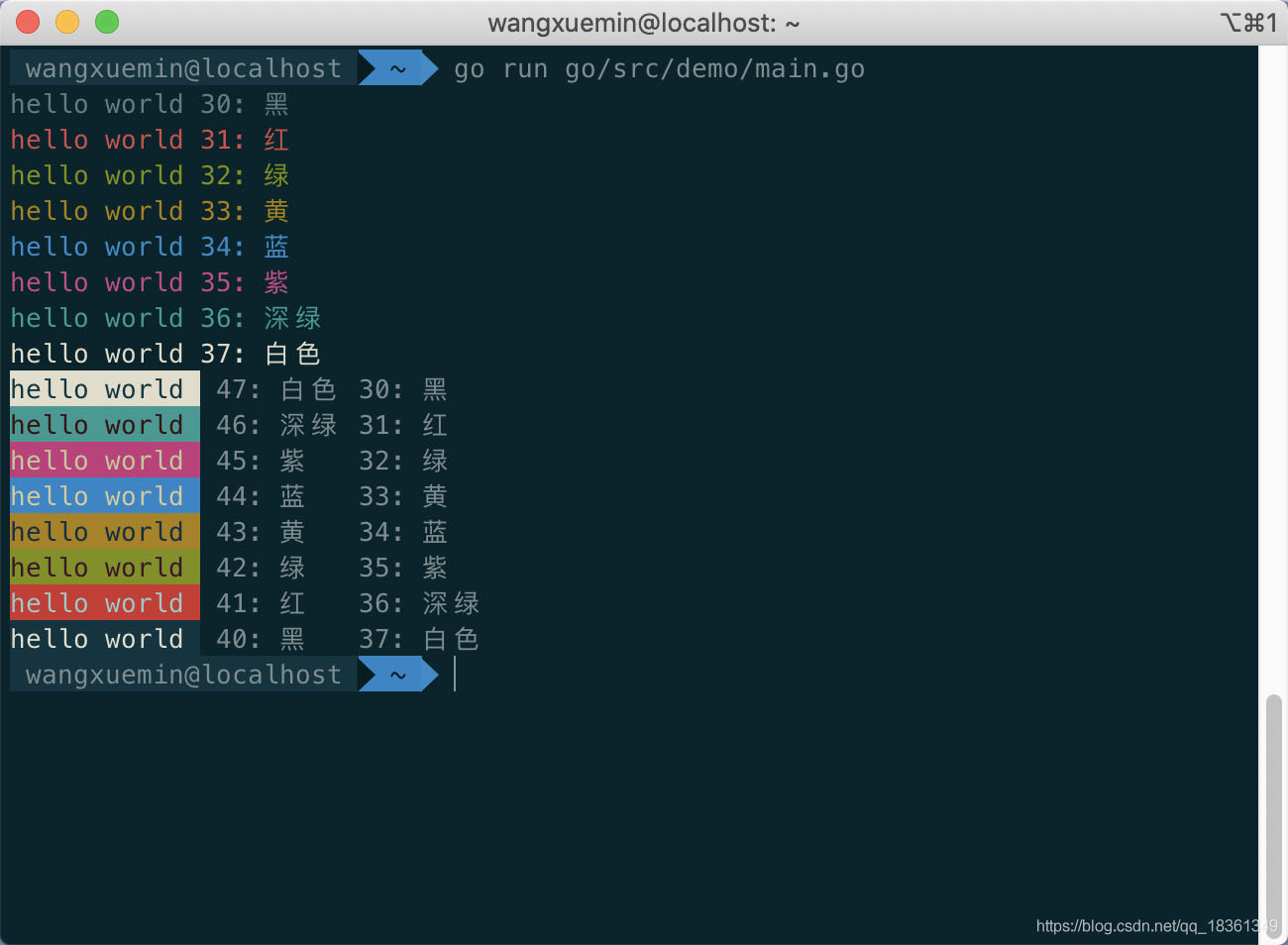如何让shell终端和goland控制台输出彩色的文字
来源:脚本之家
时间:2022-12-31 08:58:53 278浏览 收藏
IT行业相对于一般传统行业,发展更新速度更快,一旦停止了学习,很快就会被行业所淘汰。所以我们需要踏踏实实的不断学习,精进自己的技术,尤其是初学者。今天golang学习网给大家整理了《如何让shell终端和goland控制台输出彩色的文字》,聊聊输出、goland控制台、彩色,我们一起来看看吧!
终端输出彩色文字
开发工具:Mac,Goland,Mac自带shell。这是基于Mac的测试结果,根据读者留言,在Windows上不生效,标识符不一样。
在终端输出这段命令,将的到一个红色背景、绿色文字,并不停闪烁的输出。
sszxr:~ sszxr$ echo -e "\033[5;32;41mI ♡ You \033[0m" I ♡ You sszxr:~ sszxr$
双引号中的反斜杠\表示转义,033是标识符,表示用来设置颜色,[表示开始颜色设置,m为颜色设置结束。[后面的5表示闪烁,分号后面的32表示前景色,也就是文字的颜色,为绿色;再后面41表示背景色,为红色,到m为设置结束,后面是输出的内容,最后为再一次设置颜色,0m表示取消颜色设置。
从括号[到m中间为颜色设置,以;号分隔。
样式有【0,1,4,5,7,8】六种,分别是:
0 终端默认设置 1 高亮显示 4 使用下划线 5 闪烁 7 反白显示 8 不可见
颜色有7中,分别为
前景 背景 颜色 30 40 黑色 31 41 红色 32 42 绿色 33 43 黄色 34 44 蓝色 35 45 紫红色 36 46 青蓝色 37 47 白色
3开头是前景色,也就是文字的颜色;4开头是背景色。
Go语言中的彩色输出
样式和颜色与上面一样,只是标识符不一样,
fmt.Printf("%c[0;41;36m%s%c[0m\n", 0x1B, "testPrintColor", 0x1B)
标识符为0x1B,具体设置也是在[到m之间,以分号;分隔。
另一种方式
package main
import (
"fmt"
)
var (
greenBg = string([]byte{27, 91, 57, 55, 59, 52, 50, 109})
whiteBg = string([]byte{27, 91, 57, 48, 59, 52, 55, 109})
yellowBg = string([]byte{27, 91, 57, 48, 59, 52, 51, 109})
redBg = string([]byte{27, 91, 57, 55, 59, 52, 49, 109})
blueBg = string([]byte{27, 91, 57, 55, 59, 52, 52, 109})
magentaBg = string([]byte{27, 91, 57, 55, 59, 52, 53, 109})
cyanBg = string([]byte{27, 91, 57, 55, 59, 52, 54, 109})
green = string([]byte{27, 91, 51, 50, 109})
white = string([]byte{27, 91, 51, 55, 109})
yellow = string([]byte{27, 91, 51, 51, 109})
red = string([]byte{27, 91, 51, 49, 109})
blue = string([]byte{27, 91, 51, 52, 109})
magenta = string([]byte{27, 91, 51, 53, 109})
cyan = string([]byte{27, 91, 51, 54, 109})
reset = string([]byte{27, 91, 48, 109})
disableColor = false
)
func main() {
str := "hello world"
fmt.Println(greenBg, str, reset)
fmt.Println(whiteBg, str, reset)
fmt.Println(yellowBg, str, reset)
fmt.Println(redBg, str, reset)
fmt.Println(blueBg, str, reset)
fmt.Println(magentaBg, str, reset)
fmt.Println(cyanBg, str, reset)
word := "I love you"
fmt.Println(green, word, reset)
fmt.Println(white, word, reset)
fmt.Println(yellow, word, reset)
fmt.Println(red, word, reset)
fmt.Println(blue, word, reset)
fmt.Println(magenta, word, reset)
fmt.Println(cyan, word, reset)
}
运行结果

[]byte{}中那些数字是什么意思
他们是0x1B [ ; m以及0-9的ASCII编码
package main
import "fmt"
func main() {
fmt.Print(0x1B, '[', ';', 'm', '0', '1', '2', '3', '4', '5', '6', '7', '8', '9', "\n")
fmt.Printf("%#X\t%c\t%c\t%c\t", 27, 91, 59, 109)
fmt.Printf("%c\t%c\t%c\t%c\t%c\t%c\t%c\t%c\t%c\t%c\t", 48, 49, 50, 51, 52, 53, 54, 55, 56, 57)
}
运行结果
27 91 59 109 48 49 50 51 52 53 54 55 56 57
0X1B [ ; m 0 1 2 3 4 5 6 7 8 9
27代表0x1B
91代表[
59代表;
109代表m
57代表9,表示设置字体颜色
52代表4,表示设置背景色
51代表3,表示设置前景色,也就是文字的颜色
90到97与30到37的效果一样,一个是设置字体颜色,一个是设置前景色,所以57和51可以互换,效果完全一样,
reset表示0x1B[0m,表示清除颜色设置。
package main
import (
"fmt"
)
var (
black = string([]byte{27, 91, 57, 48, 109})
red = string([]byte{27, 91, 57, 49, 109})
green = string([]byte{27, 91, 57, 50, 109})
yellow = string([]byte{27, 91, 57, 51, 109})
blue = string([]byte{27, 91, 57, 52, 109})
magenta = string([]byte{27, 91, 57, 53, 109})
cyan = string([]byte{27, 91, 57, 54, 109})
white = string([]byte{27, 91, 57, 55, 59, 52, 48, 109})
reset = string([]byte{27, 91, 48, 109})
disableColor = false
)
func main() {
word := "I love you"
fmt.Println(black, word, reset)
fmt.Println(red, word, reset)
fmt.Println(green, word, reset)
fmt.Println(yellow, word, reset)
fmt.Println(blue, word, reset)
fmt.Println(magenta, word, reset)
fmt.Println(cyan, word, reset)
fmt.Println(white, word, reset)
}

补充:Golang终端彩色输出
终端彩色输出
func main() {
fmt.Printf("\x1b[%dmhello world 30: 黑 \x1b[0m\n", 30)
fmt.Printf("\x1b[%dmhello world 31: 红 \x1b[0m\n", 31)
fmt.Printf("\x1b[%dmhello world 32: 绿 \x1b[0m\n", 32)
fmt.Printf("\x1b[%dmhello world 33: 黄 \x1b[0m\n", 33)
fmt.Printf("\x1b[%dmhello world 34: 蓝 \x1b[0m\n", 34)
fmt.Printf("\x1b[%dmhello world 35: 紫 \x1b[0m\n", 35)
fmt.Printf("\x1b[%dmhello world 36: 深绿 \x1b[0m\n", 36)
fmt.Printf("\x1b[%dmhello world 37: 白色 \x1b[0m\n", 37)
fmt.Printf("\x1b[%d;%dmhello world \x1b[0m 47: 白色 30: 黑 \n", 47, 30)
fmt.Printf("\x1b[%d;%dmhello world \x1b[0m 46: 深绿 31: 红 \n", 46, 31)
fmt.Printf("\x1b[%d;%dmhello world \x1b[0m 45: 紫 32: 绿 \n", 45, 32)
fmt.Printf("\x1b[%d;%dmhello world \x1b[0m 44: 蓝 33: 黄 \n", 44, 33)
fmt.Printf("\x1b[%d;%dmhello world \x1b[0m 43: 黄 34: 蓝 \n", 43, 34)
fmt.Printf("\x1b[%d;%dmhello world \x1b[0m 42: 绿 35: 紫 \n", 42, 35)
fmt.Printf("\x1b[%d;%dmhello world \x1b[0m 41: 红 36: 深绿 \n", 41, 36)
fmt.Printf("\x1b[%d;%dmhello world \x1b[0m 40: 黑 37: 白色 \n", 40, 37)
}
终端显示

取值范围
前景 背景 颜色 30 40 黑色 31 41 红色 32 42 绿色 33 43 黄色 34 44 蓝色 35 45 紫色 36 46 深绿 37 47 白色
以上为个人经验,希望能给大家一个参考,也希望大家多多支持golang学习网。如有错误或未考虑完全的地方,望不吝赐教。
到这里,我们也就讲完了《如何让shell终端和goland控制台输出彩色的文字》的内容了。个人认为,基础知识的学习和巩固,是为了更好的将其运用到项目中,欢迎关注golang学习网公众号,带你了解更多关于golang的知识点!
-
343 收藏
-
476 收藏
-
121 收藏
-
415 收藏
-
101 收藏
-
277 收藏
-
144 收藏
-
406 收藏
-
303 收藏
-
170 收藏
-
345 收藏
-
370 收藏
-
225 收藏
-
227 收藏
-
110 收藏
-
283 收藏
-
423 收藏
-

- 前端进阶之JavaScript设计模式
- 设计模式是开发人员在软件开发过程中面临一般问题时的解决方案,代表了最佳的实践。本课程的主打内容包括JS常见设计模式以及具体应用场景,打造一站式知识长龙服务,适合有JS基础的同学学习。
- 立即学习 543次学习
-

- GO语言核心编程课程
- 本课程采用真实案例,全面具体可落地,从理论到实践,一步一步将GO核心编程技术、编程思想、底层实现融会贯通,使学习者贴近时代脉搏,做IT互联网时代的弄潮儿。
- 立即学习 516次学习
-

- 简单聊聊mysql8与网络通信
- 如有问题加微信:Le-studyg;在课程中,我们将首先介绍MySQL8的新特性,包括性能优化、安全增强、新数据类型等,帮助学生快速熟悉MySQL8的最新功能。接着,我们将深入解析MySQL的网络通信机制,包括协议、连接管理、数据传输等,让
- 立即学习 500次学习
-

- JavaScript正则表达式基础与实战
- 在任何一门编程语言中,正则表达式,都是一项重要的知识,它提供了高效的字符串匹配与捕获机制,可以极大的简化程序设计。
- 立即学习 487次学习
-

- 从零制作响应式网站—Grid布局
- 本系列教程将展示从零制作一个假想的网络科技公司官网,分为导航,轮播,关于我们,成功案例,服务流程,团队介绍,数据部分,公司动态,底部信息等内容区块。网站整体采用CSSGrid布局,支持响应式,有流畅过渡和展现动画。
- 立即学习 485次学习
